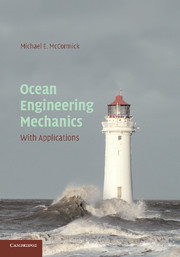Book contents
- Frontmatter
- Contents
- Preface
- Notation
- OCEAN ENGINEERING MECHANICS
- 1 Introduction
- 2 Review of Hydromechanics
- 3 Linear Surface Waves
- 4 Nonlinear Surface Waves
- 5 Random Seas
- 6 Wave Modification and Transformation
- 7 Waves in the Coastal Zone
- 8 Coastal Engineering Considerations
- 9 Wave-Induced Forces and Moments on Fixed Bodies
- 10 Introduction to Wave-Structure Interaction
- 11 Wave-Induced Motions of Floating Bodies
- 12 Wave-Induced Motions of Compliant Structures
- Appendices
- References
- Index
10 - Introduction to Wave-Structure Interaction
Published online by Cambridge University Press: 05 June 2012
- Frontmatter
- Contents
- Preface
- Notation
- OCEAN ENGINEERING MECHANICS
- 1 Introduction
- 2 Review of Hydromechanics
- 3 Linear Surface Waves
- 4 Nonlinear Surface Waves
- 5 Random Seas
- 6 Wave Modification and Transformation
- 7 Waves in the Coastal Zone
- 8 Coastal Engineering Considerations
- 9 Wave-Induced Forces and Moments on Fixed Bodies
- 10 Introduction to Wave-Structure Interaction
- 11 Wave-Induced Motions of Floating Bodies
- 12 Wave-Induced Motions of Compliant Structures
- Appendices
- References
- Index
Summary
In this chapter, basic analyses of the interactions of waves and compliant fixed and floating structures are presented. The reason for discussing both fixed and floating structures in a single chapter is that several of the analytical techniques are common to both. As in the previous chapters, the structural geometries studied here are those that can be dealt with on an analytical basis. The analyses of wave interactions with complicated structural geometries require the use of numerical techniques, such as finite-element analysis. Such situations are not addressed herein. The initial discussions of each type of structure are based on the assumption that the incident wave field is composed of regular, linear waves. These discussions are followed by considerations of structural motions in irregular (random), linear seas. Depending on water depth at the site, the wind fetch, and the wind duration, the irregular-wave analyses presented in Chapter 5 can be used for seas having a Beaufort Wind Force Scale up to 5. Sea states are used to quantify the severity of a sea, and are discussed in Chapter 1. The various sea-state scales are presented in Table 1.2.
Basic Concepts
As introduced in Section 9.2, the ambient water mass excited by an unsteadily moving body is called the added mass. The magnitude of the added mass is proportional to the inertial reaction force on the body resulting from the body motions. When the body moves close to the free surface, waves are also created.
- Type
- Chapter
- Information
- Ocean Engineering MechanicsWith Applications, pp. 350 - 375Publisher: Cambridge University PressPrint publication year: 2009



